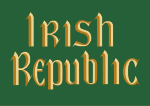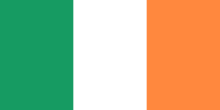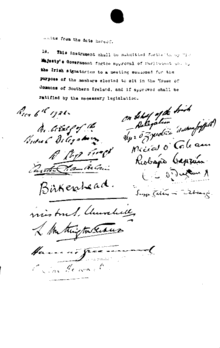Irish Republic
|
Poblacht na hÉireann (Saorstát Éireann) Irish Republic Irish Republic 1919–1922 |
|||||
|---|---|---|---|---|---|
|
|||||
|
|||||
| Official language | Irish , English | ||||
| Capital | Dublin | ||||
| Form of government | Parliamentary republic | ||||
| Form of government | Parliamentary democracy | ||||
|
Head of State - 1919 to 1921 - 1921 to 1922 |
President of the Dáil Éireann (Príomh Aire) President of the Republic |
||||
|
Area - 1921 |
84,116 km² |
||||
|
Population - 1921 |
4.4 million |
||||
|
Population density - 1921 |
52 inhabitants per km² |
||||
| currency | Pound Sterling | ||||
| Existence period | 1919-1922 | ||||
| independence |
Declaration of Independence : January 21, 1919 |
||||

|
|||||
The Irish Republic ( Irish : Poblacht na hÉireann or Saorstát Éireann ) was the predecessor of today's Republic of Ireland , founded in 1949, a revolutionary state that was unilaterally proclaimed by Irish nationalists in order to achieve Ireland's independence from the United Kingdom of Great Britain and Ireland . Efforts to do this began in the 1910s with the intention of ousting the British government in Ireland and were in opposition to the aim of the Irish Parliamentary Party , which was trying to achieve autonomous self-government within the UK . The Irish War of Independence from 1919 to 1921 was a war between Great Britain and the army of that revolutionary state, the Irish Republican Army ( IRA ).
During the war, political organs emerged in the republic that had the support of the majority of the Irish population. Internationally, however, the Irish Republic was only recognized by Russia , and so it happened that the attempt to end the British presence on the island failed. Although the republic encompassed the entire island, the government's influence did not extend into the unionist-dominated areas of the northeast (what is now Northern Ireland ). The end of the Irish Republic is equated with the establishment of the Irish Free State in 1922.
Surname
In the English language , the state is known as the Irish Republic, or occasionally the Republic of Ireland . There are also two terms in the Irish language: Poblacht na hÉireann and Saorstát Éireann - depending on how the word republic is translated into Irish. Poblacht is the borrowed and “Gaelic” word Republic from English or res publica from Latin . Saorstát is a combination of the two Irish words saor (free) and stát (state). A small modification of the last variant, Saorstát na hÉireann , and, more recently, the Latin version Respublica Hibernica also designate this historical state.
The name Poblacht na hÉireann is the one used in the 1916 Easter Proclamation . However, Saorstát Éireann was the preferred name in the Declaration of Independence and other documents ratified in 1919 . When the Irish Free State was created in 1922 by the Anglo-Irish Treaty , Saorstát Éireann was also adopted as the official Irish title. Since the Free State was not a republic, but a constitutional monarchy within the British Empire, the word saorstát has not been used as a translation of "republic" since then . When the Irish state became the Republic of Ireland in 1949 , the official Irish name was therefore Poblacht na hÉireann .
founding
In 1916, during the Easter Rising , nationalist rebels proclaimed the Irish Republic by reading the Easter Proclamation. Through this reading they declared independence and appointed the leaders of the insurrection as the "Provisional Government of the Irish Republic" until it would be possible to elect a national parliament. However, the Easter Rising was quickly crushed and the rebels had little popular support at the time. A situation that should change quickly.
In the 1918 election (in Ireland and Great Britain), the candidates for the radical Sinn Féin party (including many participants in the Easter Rising) achieved a large majority of seats. Instead of taking their seats in Parliament in Westminster , they boycotted the British Parliament , gathered at the Mansion House in Dublin in January 1919 and on that day ( see First Dáil ) retroactively ratified the Irish Declaration of Independence.
On the same day, two members of the Royal Irish Constabulary were killed by the Irish Volunteers near Soloheadbeg, County Tipperary , when they were escorting a load of explosives. This incident was not ordered by the Dáil, but it resulted in the volunteers becoming the Irish Republican Army (IRA). The assassination is also considered to be the beginning of the Irish War of Independence between the 'Irish Republic' and Great Britain.
The leaders of the Easter Rising had decided to proclaim a republic. Nevertheless, some of them were ready to ask the German prince Joachim of Prussia (son of Wilhelm II ) if he wanted to become "King of Ireland". In the years following the Easter Rising, two camps formed within Sinn Féin: the monarchists under Arthur Griffith , who preferred a form of double monarchy between Ireland and Great Britain, and the republicans under Éamon de Valera . A compromise was found here in 1917: it was agreed that the party would strive to establish an independent republic in the short term and then let it decide on the form of government in a referendum. In the event of a monarchy, it was agreed that this would not be allowed to become a member of the British royal family.
The decision to proclaim a republic rather than another form of government in 1919 was astonishing, as it meant a complete rejection of all constitutional ties with Great Britain and originally blocked the way to any compromise of an autonomous state within the United Kingdom under the 1914 Home Rule The problem that the North East would never become part of an Irish republic was already known at that time but was not resolved. This led to the fact that under the Government of Ireland Act 1920 the division was confirmed without military countermeasures by the Irish government.
government
The central institution of the republic was Dáil Éireann , which met as a unicameral parliament. While the First Dáil consisted of members elected in 1918, the two subsequent elections carried out by the British government were viewed by the nationalists as elections for the Dáil. The Second Dáil (1921) consisted of elected members in the elections to the Northern Irish Parliament and the Temporary Southern Irish Parliament . The Third Dáil was elected in 1922 as the provisional parliament of the 26 counties that would later form the Irish Free State .
The military branch of the republic was taken over by the Irish Volunteers , who were renamed the Irish Republican Army shortly after the outbreak of the War of Independence in order to underpin their status as a state army . Although in theory the army was under the command of the Dáil, in reality it had relative autonomy.
The court system of the republic consisted of a network of so-called Dáil courts , administered by IRA officers, who at first acted in parallel with the British court system, but who later increasingly replaced them.
President of the Republic
President of the Republic was the title of Head of State in the Irish Ministry ( Aireacht ). He was created in August 1921 according to the specifications of the Dáil constitution and replaced the previous title of Priomh Aire (or President of the Dáil Éireann ). In contrast to the previous title, which only included the head of the government, the President of the Republic was the explicit head of state of the Irish Republic.
List of presidents
- Éamon de Valera : Sinn Féin (August 1921 to January 1922)
- Arthur Griffith : Sinn Féin Wing of Proponents of the Treaty (January to August 1922)
- After de Valera resigned, Griffith was elected to this office, and although he preferred the previous title of President of the Dáil Éireann , he never changed the constitution in this regard. At the same time, Michael Collins took on the parallel role as chairman of the Provisional Government of the state created by the Anglo-Irish Treaty, which the United Kingdom recognized in contrast to the government of the Irish Republic and whose formation was a prerequisite for the implementation of the treaty.
- William Thomas Cosgrave : Sinn Féin wing of the proponents of the treaty (August to December 1922)
- After the natural death of Arthur Griffith and the assassination of Michael Collins in August 1922, Cosgrave took over both offices until the Free State Constitution came into force in December of that year, so that both states (Provisional Government and Irish Republic) merged even more. In September 1922, at parliamentary assemblies, it was no longer clear whether they were meeting as a Dáil or a provisional parliament.
Struggle for recognition
The efforts of President de Valera in the USA and those of Ambassador Sean T. O'Kelly at the Peace Conference in Versailles for international recognition failed, although O'Kelly was in Paris in April 1919 and Dr. Pat McCartan had set up a “embassy” of the Republic in Washington, DC . Despite great support from prominent Americans of Irish descent, US President Woodrow Wilson refused to put the "Fall of Ireland" on the conference agenda. The only foreign recognition came from the Russian Soviet Socialist Federative Republic under Lenin , which borrowed money from Michael Collins' Ministry of Finance and repaid it in tsarist crown jewels. This was a brief surge to the socialist side within the republican movement.
The Irish Republic was never officially recognized by the British government. In 1921, through the Government of Ireland Act , the British government divided the island of Ireland into two regions with their own parliaments, in accordance with the unionist demands from Ulster : Southern Ireland and Northern Ireland . While the Northern Irish Parliament met for the first time in June, the Irish nationalists refused to recognize a "Southern Ireland".
When the Republic sent envoys to peace negotiations with the British government under David Lloyd George in December 1921 , the Dáil designated them as plenipotentiaries acting under the authority of the President of the Republic. But Lloyd George refused to view the negotiations as talks between two sovereign states, but saw the delegates as representatives of the Irish people. After the Anglo-Irish treaty was negotiated, the British government even demanded that the Irish ratify the treaty not through the Dáil but through the House of Commons in Southern Ireland , although the members of both houses were almost identical. During the transition to the Irish Free State, the UK government also transferred state power to the Irish Provisional Government rather than to the Ministerial Office of the Irish Republic. This was also more of an effort by the British government to save face, as both offices were practically identical.
resolution
With the adoption of the Anglo-Irish Treaty in December 1921 and the Constitution of the Irish Free State in October 1922, the Dáil agreed to the dissolution of the Irish Republic and its replacement by the constitutional monarchy of the Free State. In the Third Dáil , elected under the terms of the Anglo-Irish Treaty, only members who were elected in the Free State sat, and so the area of the Irish Republic was reduced to its present size.
In 1922 the Provisional Government was established. But the Irish Republic was not yet gone, for its institutions continued to operate in parallel with those of the Provisional Authority. Therefore, the Free State had two heads of state for a transitional period: Michael Collins as Chairman of the Provisional Government and Arthur Griffith as President of the Republic. It was not until the death of the two men in August 1922 that both offices were combined in the person of William Thomas Cosgrave . On December 6, 1922, the Constitution of the Free State came into force, officially ending the existence of both the Provisional Government and the Irish Republic.
estate
The goal of those who “created” the Irish Republic was to establish a de facto independent republic that spanned the entire island of Ireland. This goal was ultimately missed by the partition, but the republic paved the way to the Free State, which in 1949 became an independent, autonomous republic, the Republic of Ireland.
In a meeting of the Dáil Éireann on April 29, 1997, the leaders of the parties Fianna Fáil (formerly opponent of the treaty) under Bertie Ahern and Fine Gael (formerly proponent of the treaty) under the Taoiseach John Bruton agreed that the day of the celebrations of Irish independence should not be the Establishment of the Irish Republic in 1919, but the creation of the Free State in 1922 as the basis, since the Free State was the first internationally recognized independent state.
The Irish Republic has been an important symbol for radical Republicans since the Irish Civil War from 1922 to 1923. The civil war began in June 1922 when both Sinn Féin and the IRA split internally into two camps: the pragmatists who supported the Free State and the hardliners among the Republicans who fought against the compromise of the secession of the 6 Northern Irish counties. Above all, the opposing parties resisted the existing role of the British King in the Irish Free State. When the Dáil ratified the Anglo-Irish Treaty, the opponents of the Eamon de Valera treaty left the vote - which meant the establishment of Fianna Fáil - saying that the Dáil was trying to destroy the Irish Republic and that they had no right to do so would have. After the supporters of the treaty had received a majority in the following election, de Valera replied “that the people could not make wrong decisions”.



